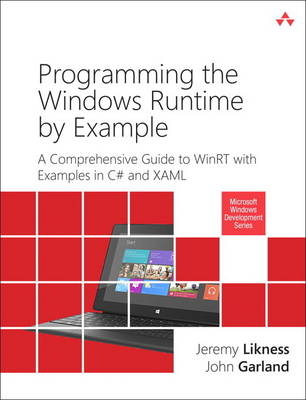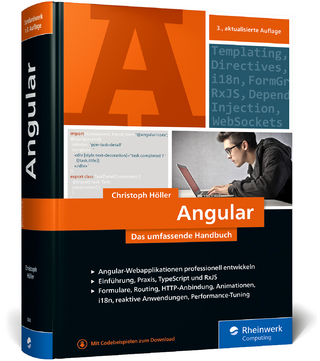
Programming the Windows Runtime by Example
Addison-Wesley Educational Publishers Inc (Verlag)
978-0-321-92797-2 (ISBN)
- Titel ist leider vergriffen;
keine Neuauflage - Artikel merken
This is the most complete, hands-on, solutions-focused guide to programming modern Windows applications with the Windows Runtime.
Leading Windows development consultants Jeremy Likness and John Garland present easy-to-adapt C# and XAML example code for more than 80 projects. Their real-world application examples help you apply Windows 8.1’s best improvements, including large tiles, the new search control, flyouts, command bars, native WinRT networking, and new deployment and sideloading options.
Drawing on their pioneering experience, they illuminate key areas of the Windows Runtime API, offering uniquely detailed coverage of encryption, cloud connectivity, devices, printers, and media integration. You’ll find cutting-edge tips and tricks available in no other book.
This is an indispensable resource for all intermediate-to-advanced Windows developers, and for any architect building desktop, tablet, or mobile solutions with Microsoft technologies. Its focus on both C# and XAML will make it valuable to millions of Windows developers already familiar with Silverlight, WPF, and/or .NET.
Coverage includes
• Creating robust app interfaces with the newest XAML controls, including flyouts and command bars
• Saving data in a persistent “roaming zone” for syncing across Windows 8.1 devices
• Using Visual State Manager (VSM) to build apps that adapt to various device resolutions and orientations
• Integrating virtually any form of data into your apps
• Connecting with web services, RSS, Atom feeds, and social networks
• Securing apps via authentication, encrypting, signing, and single sign-on with Microsoft Account, Facebook, Google, and more
• Leveraging Windows 8.1 media enhancements that improve battery life and app performance
• Networking more effectively with Windows 8.1’s revamped HTTP implementation and new location APIs
• Using Tiles and Toasts to keep apps alive and connected, even when they aren’t running
• Enabling users to send content between devices via NFC tap and send
• Ensuring accessibility and globalizing your apps
• Efficiently debugging, optimizing, packaging, and deploying your apps
• Building sideloadable apps that don’t have to be published in Windows Store
“This book doesn’t just focus on singular concepts, it also provides end-to-end perspective on building an app in WinRT. It is one of those essential tools for Windows developers that will help you complete your software goals sooner than without it!”
—Tim Heuer, Principal Program Manager Lead, XAML Platform, Microsoft Corporation
Jeremy Likness is a multi-year Microsoft MVP for XAML technologies. A Principal Consultant for Wintellect with 20 years of experience developing enterprise applications, he has worked with software in multiple verticals ranging from insurance, health and wellness, supply chain management, and mobility. His primary focus for the past decade has been building highly scalable web-based solutions using the Microsoft technology stack with client stacks ranging from WPF, Silverlight, and Windows 8.1 to HTML5 and JavaScript. Jeremy has been building enterprise line of business applications with Silverlight since version 2.0, and he started writing Windows 8 apps when the Consumer Preview was released in 2011. Prior to Wintellect, Jeremy was Director of Information Technology and served as development manager and architect for AirWatch, where he helped the company grow and solidify its position as one of the leading wireless technology solution providers in the United States prior to their acquisition by VMware. A fluent Spanish speaker, Jeremy served as Director of Information Technology for HolaDoctor (formerly Dr. Tango), where he architected a multilingual content management system for the company’s Hispanic-focused online diet program. Jeremy accepted his role there after serving as Development Manager for Manhattan Associates, an Atlanta-based software company that provides supply chain management solutions. John Garland is a Principal Consultant for Wintellect with more than 15 years of experience developing software solutions. Prior to consulting, he spent much of his career working on high-performance video and statistical analysis tools for premier sports teams, with an emphasis on the NFL, the NBA, and Division 1 NCAA football and basketball. His consulting clients range from small businesses to Fortune-500 companies, and his work has been featured at Microsoft conference keynotes and sessions. John is a Microsoft Client Development MVP, as well as a member of the Windows Azure Insiders and Windows Azure Mobile Services Advisory Board. He lives in New Hampshire with his wife and daughter, where he is an active speaker and participant in the New England software development community. He is a graduate of the University of Florida with a Bachelor’s degree in Computer Engineering and holds Microsoft Certifications spanning Windows, Silverlight, Windows Phone, and Windows Azure. John is the author of the ebook Windows Store Apps Succinctly (Syncfusion, 2013).
Foreword xix
Preface xxii
Chapter 1 The New Windows Runtime 1
Windows Runtime Specifics 1
Windows Store Apps 4
Example: Create a Windows Store App 5
.NET and WinRT 9
Fundamental Types 9
Mapped Types 10
Streams and Buffers 14
Desktop Applications 15
Example: Reference WinRT from a Desktop Application 15
Example: Examine Projections in a WinRT Component 20
Asynchronous Functions 24
Summary 27
Chapter 2 Windows Store Apps and WinRT Components 29
Fundamentals of a Windows Store App 30
Windows Store App Templates 32
Understanding the App Manifest 45
Finding Your Package on Disk 52
Running Your App 54
Application Lifecycle 61
The Navigation Helper and Suspension Manager 67
Managed WinRT Components 75
Creating a Managed WinRT Component 76
Calling Managed WinRT Components from Any Language 78
Summary 79
Chapter 3 Layouts and Controls 81
The Visual Tree 83
Data-Binding 85
Dependency Properties 91
Attached Properties 94
Value Precedence 95
Property Change Notification 95
Animations 97
Example: Dynamically Apply Animations to a Control 97
The Visual State Manager 100
Example: Visual State Manager 101
Groups 103
States 105
Transitions 106
The Visual State Manager Workflow 107
Programmatic Access to Visual States 109
Custom Visual State Managers 109
Styles 111
Templates 112
Example: Using Templates 112
Layouts 115
Panel 115
Border 115
Canvas 116
Grid 116
StackPanel 117
VirtualizingPanel and VirtualizingStackPanel 118
WrapGrid 119
VariableSizedWrapGrid 119
ContentControl 120
ItemsControl 121
ScrollViewer 122
ViewBox 122
GridView 123
ListBox 123
ListView 124
FlipView 124
Example: Using the Viewbox and Various Layouts 125
Controls 130
Flyouts 133
Custom Controls 135
Example: Creating a Custom Control 136
Parsing XAML 140
HTML Pages 143
Example: Working with HTML and JavaScript 144
Summary 150
Chapter 4 Data and Content 153
Example: Data Manipulation with the Skrape App 154
The Clipboard 154
Application Storage 159
Roaming Data 161
Containers 162
Settings 163
Composite Values 165
Storage Folders and Files 166
Storage Folders 168
Storage Files 170
Buffers and Streams 171
Path and File Helper Classes 174
Storage Query Operations 176
Pickers and Cached Files 180
Compression 187
Data Formats 191
Example: Working with Data Formats 192
XSLT Transformations 195
Document Data 196
Summary 198
Chapter 5 Web Services and Syndication 199
SOAP 200
REST 209
OData Client 217
Syndication 219
Summary 223
Chapter 6 Tiles and Toasts 225
Tiles 226
Default Tiles 227
Live Tiles 229
Cycling Tile Notifications 234
Secondary Tiles 236
Badges 239
Periodic Notifications 242
Toasts 242
Toasts in Desktop Applications 248
Push Notifications 249
Registering to Receive Push Notifications 251
Sending Push Notifications 253
Summary 259
Chapter 7 Connecting to the Cloud 261
Windows Azure Mobile Services 262
Example: Managing a Shared Group of Subscribers 267
Connecting an App to a Mobile Services Instance 267
Authentication 269
Data Storage 274
Custom APIs 289
Integrated Push Notification Support 291
Scheduled Tasks 297
Mobile Services Deployment Tiers 298
Live Connect 301
Getting Started 302
The Example App 304
Authentication 304
Working with Profile Information 308
Working with Contacts 310
Working with Calendars and Events 311
Working with OneDrive 315
Summary 321
Chapter 8 Security 323
Authentication 324
Multistep Authentication (Google) 330
Unlocking the Password Vault 331
Encryption and Signing 333
The Data Protection Provider 333
Symmetrical Encryption 337
Verification 343
Asymmetric Algorithms 345
Summary 347
Chapter 9 Model-View-ViewModel (MVVM) 349
UI Design Patterns 350
The Model 351
The View 352
Model-View-Controller (MVC) 353
Model-View-Presenter (MVP) 354
Model-View-ViewModel (MVVM) 355
The ViewModel Decomposed 356
Common MVVM Misperceptions 362
Benefits of MVVM 364
Common MVVM Solutions 367
Design-Time Data 367
Accessing the UI Thread 369
Commands 371
Handling Dialogs 371
Selection Lists 371
Filtered Lists 373
Validation 375
Summary 377
Chapter 10 Networking 379
Web and HTTP 379
HomeGroup 382
Connectivity and Data Plans 384
Sockets 389
WebSockets 389
UDP and TCP Sockets 392
Proximity (Near Field Communications) 397
NFC-Only Scenarios 397
Tap-to-Connect Scenarios 403
Background Transfers 408
Summary 412
Chapter 11 Windows Charms Integration 415
Displaying App Settings 417
The Settings Example 418
Adding Settings Entries 418
Sharing 421
The Share Source Example 423
Creating a Share Source App 424
The Share Target Example 433
Creating a Share Target App 434
Debugging Share Target Apps 441
Using Play To 442
The Play To Example 443
Creating a Play To Source App 444
Creating a Play To Target App 446
Summary 448
Chapter 12 Additional Windows Integration 451
Integrating with the File and Contact Pickers 452
The Example App 453
File Open Picker 454
File Save Picker 458
Contact Picker 460
Application Activation Integration 462
The Example App 463
File Activation 463
Protocol Activation 467
Account Picture Provider 470
AutoPlay 471
Working with Contacts and Appointments 473
The Example App 474
Contacts 474
Appointments 476
Summary 478
Chapter 13 Devices 479
Working with Input Devices 480
The Example App 480
Identifying Connected Input Devices 481
Pointer, Manipulation, and Gesture Events 484
Keyboard Input 495
Sensor Input 498
The Example App 498
Geolocation 502
Geofencing 510
Motion and Orientation Sensors 517
Summary 529
Chapter 14 Printers and Scanners 531
Working with Printers 532
The Example App 532
Getting Started 533
Configuring a Print Task 534
Providing Printing Content 542
Working with Scanners 547
The Example App 547
Determining Scanner Availability 548
Working with Scan Sources 549
Previewing 550
Scanning 551
Scanner Settings 552
Summary 556
Chapter 15 Background Tasks 559
The Thread Pool 560
Uploads and Downloads 562
Audio 563
Lock Screen Tasks 570
Lock Screen Capabilities 570
The Background Task 573
Listing Background Tasks 576
Timer 578
Conditions 578
Debugging Background Tasks 580
Raw Push Notifications 581
Control Channel 585
System Events 587
Summary 588
Chapter 16 Multimedia 589
Playing Multimedia Content 590
The Example App 590
Getting Started 591
Controlling Playback 592
Appearance 595
Audio Settings 596
Media Information 597
Markers 597
Acquiring Audio and Video 598
The Example App 599
Declaring Application Capabilities 599
Using CameraCaptureUI 600
Using MediaCapture 604
Text-to-Speech Support 610
The Example App 611
Using the SpeechSynthesizer 611
Summary 613
Chapter 17 Accessibility 615
Requested Theme 616
High Contrast 618
Keyboard Support 620
Automation Properties 622
Testing with Narrator 623
Automation and Lists 624
Live Settings 625
Automation Peers 626
Accessibility Checker 627
Summary 629
Chapter 18 Globalization and Localization 631
Design Considerations 632
Default Language 633
Configuring Preferred Languages 635
Resource Qualification and Matching 637
Localizing XAML Elements 639
Formatting Dates, Numbers, and Currencies for Locale 642
MVVM and Localization 643
Multilingual Toolkit 644
Summary 648
Chapter 19 Packaging and Deploying 649
Packaging Your App 650
Creating an App Package 650
App Package and App Bundle Contents 654
Package Identifier 655
Deploying Your App 657
Publishing Your App in the Windows Store 657
Other Deployment Options 665
Making Money with Your App in the Windows Store 667
The Example App 668
Pricing Your App in the Windows Store 669
Trial Mode Apps 670
In-App Purchases 675
Including Advertisements 678
Summary 683
Chapter 20 Debugging and Performance Optimization 685
Understanding the Debugger 686
Native, Managed, and Script Debuggers 686
Just My Code 688
Edit and Continue 690
Just in Time Debugging 691
How to Launch the Debugger 691
Program Databases 692
Debug Windows 693
Managing Exceptions 694
Logging and Tracing 696
Profiling and Performance Analysis 702
Performance Tips 704
CPU Sampling 706
XAML UI Responsiveness 709
Energy Consumption 710
Code Analysis 712
Summary 717
Appendix A Under the Covers 719
Fundamental WinRT Concepts 719
Namespaces 720
Base Types 720
Primitives 720
Classes and Class Methods 721
Structures 722
Generics 722
Null 723
Enumerations 723
Interfaces 723
Properties 723
Delegates 724
Events 724
Arrays 725
WinRT Internals 725
Appendix B Glossary 733
Index 749
| Verlagsort | New Jersey |
|---|---|
| Sprache | englisch |
| Maße | 179 x 231 mm |
| Gewicht | 1256 g |
| Themenwelt | Mathematik / Informatik ► Informatik ► Programmiersprachen / -werkzeuge |
| Informatik ► Software Entwicklung ► Mobile- / App-Entwicklung | |
| Informatik ► Weitere Themen ► Smartphones / Tablets | |
| ISBN-10 | 0-321-92797-4 / 0321927974 |
| ISBN-13 | 978-0-321-92797-2 / 9780321927972 |
| Zustand | Neuware |
| Haben Sie eine Frage zum Produkt? |
aus dem Bereich


